My mother-in-law is a Cantonese zongzi (rice dumpling) expert.
She was famous for making the best zongzi in her hometown in Kampar.
Since the Zongzi Festival (also called Duanwu Festival, Dragon Boat Festival) falls on the fifth month of the Chinese calendar, I decided to make my own rice dumplings, tapping into her expertise and experience of more than half a century!
Naturally, it is a huge success under the guidance of the guru. The amazing aroma of the zongzi perfumes the kitchen and provokes a feeling of satisfaction that makes my belly rumble. I just sat down to enjoy this dumpling with a bottomless pot of Pu’er tea.
This post is based on her secret recipe written in a small notebook with half faded ink, and I am grateful for her generosity and permission to share it on my blog.
Note: Zongzi is also called Chinese sticky rice dumplings, Chinese tamales, or just rice dumplings in English.
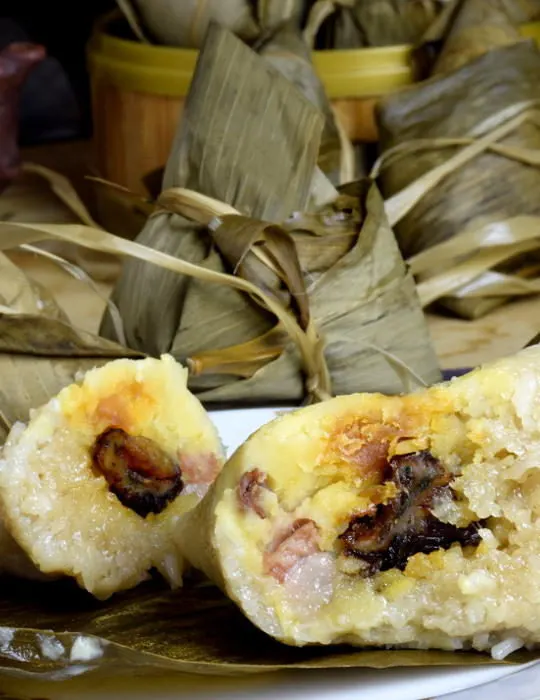
The origin
The history of zongzi 粽子is closely related to a famous poet and patriotic minister Qu Yuan 屈原 of the Kingdom of Chu during the Warring States 戰國 period of China (ranging from 481 BC to 403 BC). Qu Yuan served as a minister for the Chu but was ousted for opposing the alliance of a much larger kingdom called Qin. When the Qin eventually conquered the capital of Chu, Yingdu, the grief was so intense that he finally committed suicide by drowning himself in the Miluo River 汨羅江 on the 5th of May.
Moved by the patriotism of Qu Yuan, the local people rolling their boats to save him. The act to save Qu Yuan was the origin of the dragon boat races during this festival. After they had failed to retrieve his body, they threw packets of sticky rice into the river, hoping the fishes would eat the rice instead of his body.
Chinese people serve zongzi every year on the day when Qu Yuan committed suicide, which happens on the fifth day of the fifth month of the Chinese calendar. This day had slowly evolved to become the Duanwu Festival or Double Fifth Festival; both means the date and month as mentioned.
Note: This post may contain affiliate links. Please read my privacy policy for more info. I may receive commissions for purchases made through links in this post. As an Amazon Associate, I earn from qualifying purchases.
Duanwu 端午节- An important festival to celebrate
Duanwu Festival (also called Dragon Boat Festival) has slowly shifted its focus from commemorating Qu Yuan to become a carnival, with dragon boat competition and eating zongzi as the key features.
Today, eating this rice dumpling remains as an important tradition among the Chinese. The way of wrapping and the ingredients in the zongzi also varied considerably in different regions.
In this article, I will show you how to make the zongzi that is popular among the Cantonese people.
Making zongzi is relatively easy, except for the time commitment to prepare and cook it.
While plenty of Chinese cooking techniques rely on feel over empirical function, I try to simplify it with step-by-step instructions.
1. Prepare the leaves to wrap the rice dumplings
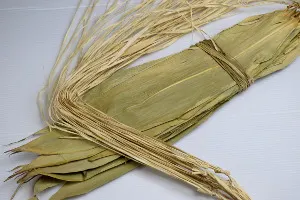
There are two types of leaves commonly used to wrap zongzi. It can be either reed leaves or bamboo leaves.
The fresh leaves are the best since it is aromatic and soft. However, it is rarely available even in Asia with a large population of Chinese. Therefore, nearly everyone who makes zongzi is using dry leaves.
Dried leaves are brittle and hard and not suitable to use it to wrap zongzi.
Therefore, you need to rehydrate the leaves before using them for wrapping.
The easiest way to prepare the leaves for wrapping is to boil them. Boil for 30 minutes and then soak it in the pot overnight.
You will find that the leaves are fully rehydrated, with dark green color the next morning.
Here are the steps:
- Wash the leaves. Wash the leaves thoroughly to remove any muds.
- Use cold water. Place the leaves in a stockpot. Fill up the pot with cold water until it is sufficient to submerge the leaves.
- Add some oil. Add a tablespoon of vegetable oil into the water. Vegetable oil helps to prevent the glutinous rice from sticking onto the leaves when you wrap the filling later.
- Use a heavy bowl. Place a bowl on top of the leaves to stop them from floating on the water.
- Boil the leaves. Use high heat to bring the water to a boil, then reduced the heat for another half an hour.
- Soak overnight. Remove the leaves from heat. Soak the leaves in the water overnight.
- Wash the leaves. Remove the leaves from the water the next day. Wash the leaves under running water. Keep the leaves in water until you want to wrap the zongzi. The leaves will become brittle again if you let them dry out.
- Snip off the end. Snip off at least three centimeters from the end near to the stem of every leaf. The part can puncture easily during wrapping.
2. Prepare the filling- a symphony of traditional Asian flavor
The following is a list of common ingredients I use to prepare Cantonese zongzi. You can omit certain ingredients if you wish to, or increase the amount of those you like. There isn’t any fixed rule to follow.
The pork
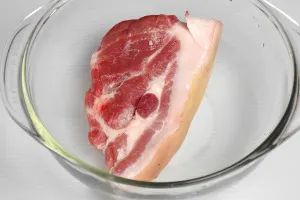
Pork belly is the indispensable ingredient in making Cantonese zongzi. The meat should be marinated overnight to give it a deep savoring flavor.
Pork belly is ideal for making zongzi as there is a little oil in other main ingredients. You can use other cuts of pork but make sure to include some fat in it.
Prepare the pork by following these steps:
- Use pork belly. Cut the pork belly (or any cut of pork with some fat) into 3cm squares.
- Marinate. Marinate the pork with light soy sauce, sugar, Shaoxing wine, ground white pepper, and salt overnight. Add more salt to give it a deep savory flavor. It will not be too salty as part of the salt will be absorbed by the rice. You can add some dark soy sauce if you prefer darker color rice dumplings.
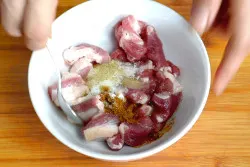
- Tips: Marinate overnight and with extra salt.
- You can add some soy sauce to marinate if you like.
The glutinous rice
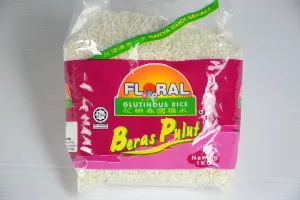
Glutinous rice 糯米 (also called sweet rice) is the major component of the filling. It is the only type of rice suitable for making rice dumplings.
Look for a good brand of glutinous rice. I have encountered some unscrupulous vendor adulterate the glutinous rice with other cheaper rice.
- Rince and soak the rice. Rinse the glutinous rice a few times under running water until the water is clear.
- Soak the glutinous rice in water overnight (or at least four hours).
- Add some salt. Drain the water away and mix with light soy sauce and salt. Set aside for wrapping the zongzi.
- Stir-fry. Stir-fry with some vegetable oil briefly. (Optional)
Mung beans
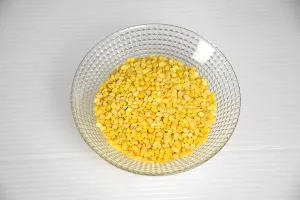
There are a few types of beans and nuts for making rice dumpling. Groundnuts, mung beans and black eye peas are among the popular one. I use mung beans in this recipe, follow my mother-in-law’s recommendation. She made Cantonese zongzi for many years who is an accomplished zongzi expert.
- Rince. Rince the mung beans.
- Soak. Soak the mung beans for an hour. Then mix with the seasonings.
- Stir-fry. Stir-fry with some vegetable oil briefly. (Optional)
Note that you may notice some mung beans are green and some are yellow as what I use. You need to remove the green outer skin of the mung beans by soaking them in water overnight. Since it is tedious, most people who make zongzi will buy the mung beans with the skin already removed, which is yellow.
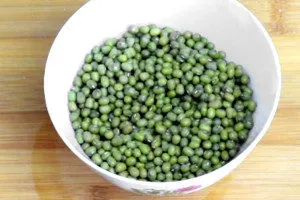
- Mung beans before removing the skin. This is suitable to prepare mung bean soup, but not for rice dumpling.
- Choose the one with the skin removed. It saves you time.
Shiitake mushroom
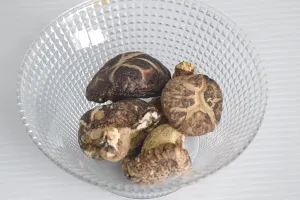
Shiitake mushroom is a common ingredient for zongzi. It has the aromatic flavor complement to the pork and salted egg yolks.
- Soak the mushrooms. Soak the dry shiitake mushrooms in water for two hours or until fully rehydrated. You can shorten the soaking time with hot water.
- Cut into strips. Remove the stems. Cut the mushrooms into thin strips.
- Set aside for wrapping the zongzi.
Chestnuts
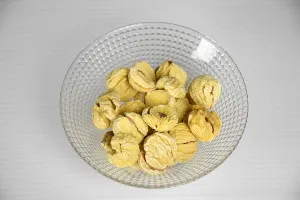
Chestnuts are optional. However, I like to include in the recipe as it has a strong contrast to the meaty flavor of the pork and the sticky texture of the glutinous rice.
You can roast them briefly before using it to wrap the rice dumpling. It is optional.
- Soak and clean. Soak the chestnuts in water. Clean the chestnut before use.
- Toast. Lightly toast them before using it to wrap zongzi
Dried oysters and dried shrimps
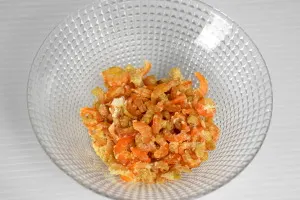
Dried seafood renders a deep savory flavor to the rice dumplings. Try to get it at the Asian grocery shop which sells dried seafood. Some people do not include in the dumpling due to the higher cost, but I bet you will love the unique flavor, which is way apart from the fresh one.
- Soak. Soak both dried seafood for at least one hour.
- Clean. Clean with water thoroughly to remove any sand and impurities.
- Stir-fry. Stir-fry with some vegetable oil briefly. (Optional)
You can get these ingredients at your favorite Asian market or any other store that sells traditional Chinese food items.
Salted duck egg yolk

The preparation of salted duck egg yolks is straightforward. You are lucky if you manage to buy the yolks alone (without the white). If not, you have to buy the whole salted eggs and figure out what to do with the whites.
Salted egg is a familiar delicacy in a variety of Asian dishes. It is duck egg, not chicken. The eggs are either boiled in water or steam before eating. You can just eat with steamed rice or congee, or as an ingredient in a recipe. Cantonese zongzi often includes the salted egg yolk for its unique flavor. Since it is salty, the flavor is still intense after cooking the zongzi for hours.
Other ingredients
The above ingredients are what my mother-in-law uses, but you can also consider adding various fillings to the rice dumplings. Red beans and Chinese sausages are two common items you can consider.
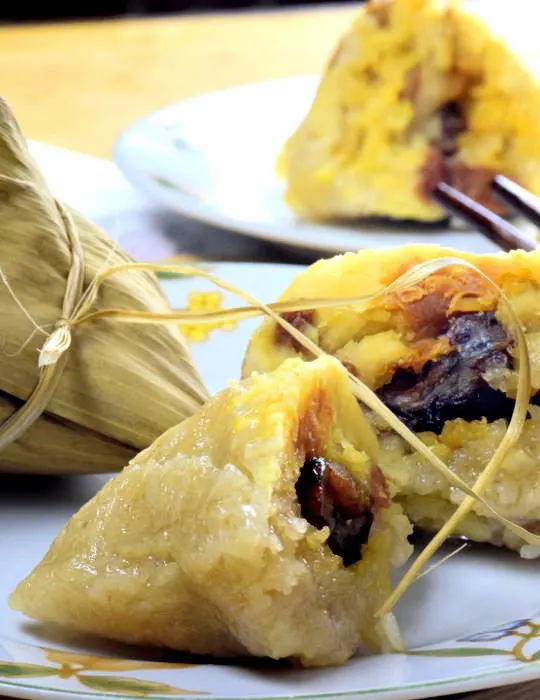
3. How to wrap zongzi
Now it comes to the most challenging and exciting part- wrapping the zongzi, how to wrap zongzi with a pyramid shape.
Follow these steps, and watch the video demonstration embedded in this post.
- Use two leaves. Pick two pieces of leaves, smooth side up. Place the smaller one slightly to the left and on top of the large piece.
- Form a cone. Layering two leaves together and folding them up at the center of the leave on top to form a cone. Use the middle finger to make a small fold inward fold. Turn the leaf around to form a cone shape. (Hint: Watch the video demo.)
- Fill up the cone with the filling. Fill the cone with a tablespoon of glutinous rice at the bottom. Then add the egg yolk, pork belly, dry oyster, mung beans, and mushroom.
- Cover the filling with two tablespoons of glutinous rice.
Fold and wrap: - Hold the cone with one hand to secure its shape.
- Fold down the leave to close the cone. Press it firmly, so it will not fall apart and get a tight seal.
- Fold the extra leaves to one side of the zongzi.
- Lastly, secure the shape of the zongzi with a twine.
Follow the illustration below or refer to the video for the demonstration
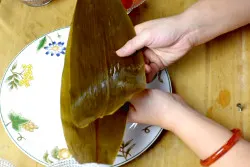
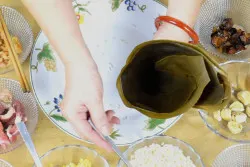
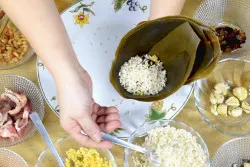
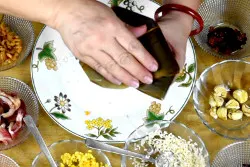
4. How to tie the zongzi
You may try to get the special twine to wrap zongzi from the Asian grocery shop. You can use any kitchen twine, like those trusting the turkey if it is not available.
If you use the zongzi twine, soak it in a bowl of water for half an hour before using it. The twine will rehydrate and won’t break easily.
Secure the leaves with the twine is tricky. You need some practice to get it perfect. You can watch the demonstration in the video to understand the entire wrapping process.
Here is how to do it:
Hook a bunch of string to an anchor point. Use one hand to hold the zongzi and the other to tie it tightly and a dead knot.
Note that it is important to tie them tightly since we want to cook them for a few hours. As for the knots, nearly everyone will cut the twine when they want to eat. Therefore, it does not matter whether you can easily open the knot.
5. How to cook the zongzi
Cooking zongzi is simple but lengthy. You can schedule it when you are at home, in which you can do another thing while cooking. There aren’t many things you need to do after you set the pot on the stove. Just wait and add some water occasionally if necessary.
Follow the steps below:
- Use a stockpot. Bring a large pot of water to a boil. The amount of water should be enough to submerge all the zongzi.
- Boil for six hours. Boil over low heat, i.e., reduce to a bare simmer for about six hours.
- Add only boiling water. Check the water level from time to time. Maintain the level of water to just enough to submerge all the zongzi. Add only boiling water when necessary.
- Freeze for future enjoyment. Remove them from the water after six hours. You can eat it right away or freeze them after they cool to room temperature.
6. How to reheat zongzi
Frozen zongzi can be kept up to a few months.
When you want to eat later, take them out from the freezer and defrost them at room temperature for a few hours.
Steps to reheat the zongzi
Steam to reheat
- Add about one liter of water into a wok.
- Place a steamer rack in the wok, and make sure the water level is below the steamer rack to avoid the zongzi from getting wet.
- Place the zongzi in the steamer.
Steam for twenty minutes
- Bring the water to a boil. Reduce the heat to steam for another twenty minutes.
- Switch off the stove. Do not remove the lid. Let the latent heat continue warming up the zongzi for another 5 minutes.
- Unfold the leaves and serve.
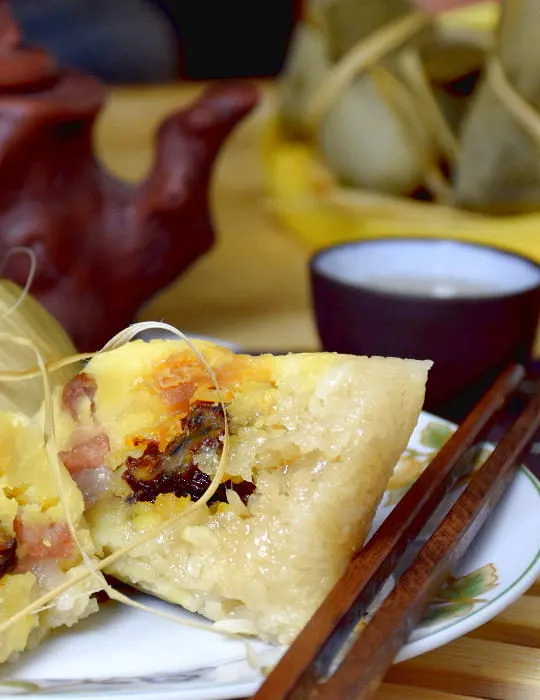
Bonus: How to prevent the leaves from sticking to the filling
The worst thing while eating zongzi is when the rice sticks onto the leaves, and unable to remove the rice dumpling in one piece. As a result, you get a mess of broken rice dumplings on your plate instead of a beautiful golden pyramid.
When you unfold the leaves, the rice dumpling may crack, deformed, and stick onto the leaves. It is messy, and certainly frustrated.
You will never have this troublesome messy encounter anymore once you master the method.
Here are some suggestions:
Add some oil
- Mixing the glutinous rice with some oil before wrapping can reduce the stickiness to the leaves.
- Add some oil to the water to cook the leaves can minimize the rice from sticking to the leaves.
- Brush a thin layer of oil on the leaves before wrapping.
Other methods
- The leaves must be rehydrated fully before wrapping.
- The smooth side of the leaves should be in contact with the filling.
- Unwrapped the zongzi while it is hot. The glutinous rice becomes stickier after it cools down.
The recipe
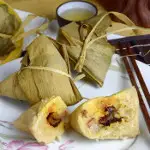
Cantonese-Style Zongzi Recipe
This the recipe for Cantonese style zongzi (rice dumpling).
Ingredients
For the pork
- 350 g pork, belly of any pork with some fat
- 2 teaspoons Chinese five-spice powder
- 1 1/2 teaspoons salt
- 1/2 teaspoon sugar
- 1/4 teaspoon ground white pepper
- 1 tablespoon Shaoxing wine
For the mushrooms
- 8 pieces Chinese dried mushrooms
- 1/2 teaspoon salt
- 1/2 teaspoon sugar
For the glutinous rice
- 1.2 kg glutinous rice
- 2 teaspoons salt
- 2 teaspoons sugar
- 2 teaspoons light soy sauce
- 1 tablespoon vegetable oil
For the mung beans
- 600 g mung beans
- 1 tablespoon salt
- 2 teaspoons sugar
- 1 tablespoon vegetable oil
Others
- 10 salted egg yolks, cut to half
- 10 chestnuts, cut to half
- 20 dry oysters
- 20 g dry shrimps
- 60 pieces bamboo leaves
Instructions
Prepare the ingredients
- Cut the pork into 20 pieces. Marinate the pork overnight or up to three two days in the refrigerator
- Soak the mushroom. Combine with the seasonings.
- Soak and rehydrate the dry oysters for one hour.
- Soak the glutinous rice overnight or at least four hours. Combine with the seasonings.
- Soak the mung beans for at least one hour. Combine with the seasonings.
- Stir-fry the glutinous rice, mung beans, dry shrimps and dry oysters until aromatic.
- Soak the chestnuts. Clean. Lightly toast the chestnuts.
- Cut the egg yolks into quarters.
Prepare the leaves
- Place the leaves in a stockpot and fill up with cold water enough to submerge the leaves.
- Place a bowl on top of the leaves to prevent them from floating.
- Add a tablespoon of vegetable oil. Bring it to a boil.
- Boil at low heat for half an hour.
- Remove and soak the leaves overnight.
- Use the leaves immediately to wrap the zongzi. Soak them in water if you want to use them later so that the leaves sill not dry out.
To wrap and tie the zongzi
- This step requires some demonstration. Please refer to the note above and watch the video.
To cook the zongzi
- Choose a stock pot with the right size to nest all the zongzi.
- Bring the water to a boil.
- Place all the zongzi into the pot. Make sure all the zongzi are submerged in the water.
- Add boiling water from time to time.
- Add boiling water from time to time if necessary. Do not add cold water.
- After six hours, remove the zongzi from the pot. Unwrap them immediately or keep them for future enjoyment. (You can freeze the zongzi up to two weeks.)
Notes
If you encounter any audio / visual problem of viewing this video, you can view it from YouTube by clicking this link, which will open in a new tab.
Recommended Products
As an Amazon Associate and member of other affiliate programs, I earn from qualifying purchases.
Nutrition Information:
Yield: 20 Serving Size: 20 servingsAmount Per Serving: Calories: 228Total Fat: 7gSaturated Fat: 2gTrans Fat: 0gUnsaturated Fat: 5gCholesterol: 55mgSodium: 862mgCarbohydrates: 25gFiber: 3gSugar: 2gProtein: 14g
This data was provided and calculated by Nutritionix on 5/25/2019
Advice from my mother in law (my mentor)
My mother-in-law is an accomplished Cantonese zongzi master with the experience of more than half a century!
While I have included some of the common advice from her in writing this post, there are a number of ‘trade secrets’ that she revealed to me, which are rarely mentioned in books and other related food blogs.
Below is a list of the secrets she wants to share with you:
- Stir-fry the glutinous rice, mung beans, dried shrimps, and dried oyster until they turn fragrant. She said many rice dumpling vendors skip this step, as it involves more work. However, this step will make the difference between the excellent and the ordinary rice dumplings.
- There is no need to use a heavy bowl to prevent rice dumplings from floating in the water while cooking, as suggested by some food bloggers. She said the rice dumplings would sink once once they absorb enough water. I tried it, and all the dumplings were floated initially, but all sank to the bottom after five minutes.
- Bring the water to a boil and cook the rice dumplings in boiling water over medium heat. She said there is no need to start with cold water. I followed her method which worked flawlessly.
- Tie the rice dumpling tightly. She stresses that the boiling water will not seep in easily through the leaves of the firmly tied rice dumplings. This method helps to preserve all the flavors of the ingredients from leaking into the water.

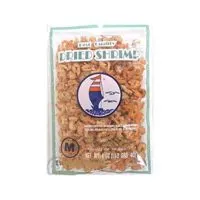
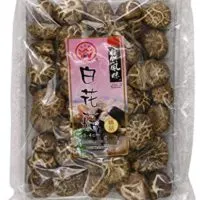
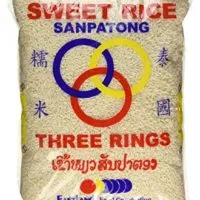

7 Ways To Use Glutinous Rice Flour In The Kitchen - CollegeUnified
Sunday 5th of January 2025
[…] ingredient used in many Asian cuisines. It is commonly used to make sticky rice dumplings, such as zongzi. The flour also makes savory pancakes and sweet treats like Chinese […]
Philip Smith
Wednesday 19th of April 2023
The flavor is purfet with the rice. hunger for more.
Aizan Bin Asmaon
Tuesday 10th of August 2021
Hello Kwan,
Thank you for being generous.
I am a believer of passing down food 'secret'. To me, food is meant to be shared and enjoyed together.
My family has a secret too. We believe that families who sat n eat together stays together.
May i ask you one question,. What is a great halal substitute for shaoxing wine?
Thk u agn.
KP Kwan
Tuesday 10th of August 2021
Hi Aizan, As a general rule, omit the wine and do not need to substitute it with anything. The difference is quite small, and it is not very noticeable. Also, if you see any pork recipe in Chinese, it can be substituted with chicken breast meat and coo the same way. That was how I did it when I worked in a pork-free restaurant before. The above works in most cases, unless it is in some particular situation in which wine is the major ingredient. I hope this is helpful. Thanks, KP K
Ivy
Wednesday 2nd of June 2021
Hi Kwan
Do you use pork belly with skin or without skin?
Thanks
Ivy
Thursday 3rd of June 2021
@KP Kwan,
Thanks
KP Kwan
Thursday 3rd of June 2021
I remove the skin.
KAREN L JONES
Saturday 17th of April 2021
we have plenty of corn leaves in my location. We use them for tamales (a corn bread layer around a chili spiced meat). We wrap the corn leaf around the corn batter that is layered with the chili and then boil the corn leaf packet for a few hours. These are called the Tamale. Very good. Any way. Do you think it would be okay to use the corn leaves for the rice zongi? Your mom in law recipe sounds so nice and I want to attempt it. xo
KP Kwan
Saturday 17th of April 2021
I have never tried using corn leaves. I think it is workable but need more leaves (or make it smaller). I am eager to know the result too.